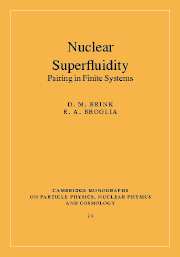Book contents
- Frontmatter
- Contents
- Preface
- 1 Introduction
- 2 The pairing force and seniority
- 3 The BCS theory
- 4 Spontaneous symmetry breaking
- 5 Pairing vibrations
- 6 Phase transitions
- 7 Plastic behaviour of nuclei and other finite systems
- 8 Sources of pairing in nuclei
- 9 Beyond mean field
- 10 Induced interaction
- 11 Pairing in exotic nuclei
- Appendix A A brief résumé of second quantization
- Appendix B Single particle in a non-local potential
- Appendix C Useful relations in the treatment of collective modes
- Appendix D Particle-vibration coupling
- Appendix E Model of the single-particle strength function
- Appendix F Simple model of Pauli principle corrections
- Appendix G Pairing mean-field solution
- Appendix H Pairing in a single j-shell
- Appendix I Fluctuations and symmetry restoration
- Appendix J RPA solution of the pairing Hamiltonian
- Appendix K Vortices in nuclei
- Appendix L Josephson effect
- References
- Index
6 - Phase transitions
Published online by Cambridge University Press: 17 August 2009
- Frontmatter
- Contents
- Preface
- 1 Introduction
- 2 The pairing force and seniority
- 3 The BCS theory
- 4 Spontaneous symmetry breaking
- 5 Pairing vibrations
- 6 Phase transitions
- 7 Plastic behaviour of nuclei and other finite systems
- 8 Sources of pairing in nuclei
- 9 Beyond mean field
- 10 Induced interaction
- 11 Pairing in exotic nuclei
- Appendix A A brief résumé of second quantization
- Appendix B Single particle in a non-local potential
- Appendix C Useful relations in the treatment of collective modes
- Appendix D Particle-vibration coupling
- Appendix E Model of the single-particle strength function
- Appendix F Simple model of Pauli principle corrections
- Appendix G Pairing mean-field solution
- Appendix H Pairing in a single j-shell
- Appendix I Fluctuations and symmetry restoration
- Appendix J RPA solution of the pairing Hamiltonian
- Appendix K Vortices in nuclei
- Appendix L Josephson effect
- References
- Index
Summary
In the present chapter we shall discuss the consequences the finite number of particles have in the phenomenon of pairing phase transition in atomic nuclei. Finite size effects give rise to fluctuations of the pairing gap and thus of the correlation length (order parameter) ξ. Because ξ is much larger than the size of the nucleus, it comes as no surprise that in describing the phase transition in the small-particle superconductors one doesn't need the non-analytic functions necessary to account for the condensation in infinite systems. On the other hand, the phenomena in both systems are closely related and, in a system like the nucleus, we have the possibility of studying the transition in terms of the spectrum of individual states. Thus the transition from a pair-correlated to a normal system with increasing angular momentum involves the coupling between rotational bands associated with the ground state and with excited (few quasiparticle) states.
Because all the transitions we shall treat are connected with level crossings at zero temperature, it is more appropriate to talk about quantal phase transitions (see Sachdev (1999)).
The variation of the moment of inertia I of rotational bands with angular momentum provides one clue to the variation of the pairing gap with angular momentum. This is because the moment of inertia has a simple monotonic dependence on Δ. In characterizing a superfluid nucleus the moment of inertia I of the rotational bands and the energy of the lowest non-collective excitations 2Ev play a central role.
- Type
- Chapter
- Information
- Nuclear SuperfluidityPairing in Finite Systems, pp. 117 - 153Publisher: Cambridge University PressPrint publication year: 2005

